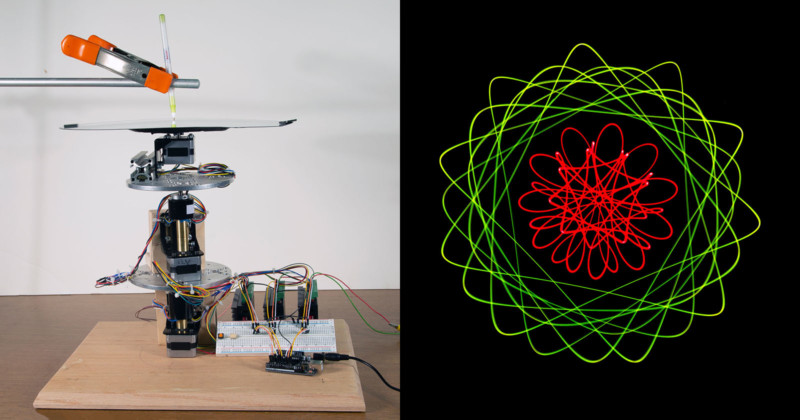The geometric chuck was a device that stacked up multiple rotating wheels that could vary their speed and their offset to a central shaft, in order to machine ornate designs using a lathe. It’s this piece of machining obscura from the 19th century that inspired this light painting build from [Ted Kinsman].
Rather than the complicated gears and wheels used in the distant past, [Ted] instead elected to use stepper motors. Three stepper motors are stacked on top of each other, each one able to rotate at an independent rate. The design only implements three steppers as the slip rings needed to send power and control signals to each stepper are prohibitively expensive.
An Arduino is programmed to run the show, changing the speed of each motor and thus the patterns the system generates. Put LEDs on the spinning plates, or install a pen to mark a piece of paper, and it’s possible to generate all manner of beautiful spirograph-like patterns. Vary the motor speeds or the positioning of the lights, and the patterns vary in turn.
It’s a fun build for light painting, with some great visuals produced. We also appreciate the use of the Arduino which makes varying the parameters far easier than having to change out gearsets in classical designs.
If you miss the old school spirograph, you can always build one out of Lego. Else, consider experimenting with other light painting techniques. If you’ve built a fancy rig of your own, be sure to let us know!
[Thanks to zit for the tip!]
















Nice built. I built a similar thing: https://hackaday.io/project/176622-laser-circles
Seems like you could just run 4 wires through each slip ring — Vmot, Gnd, I2C SDA and I2C SCL. Put a little stepper driver on each stage next to the motor to regulate Vmot down, parse the I2C, and switch the stepper. You could daisy chain stages indefinitely then, subject to the current-carrying capacity of the slip rings.
Need to get your centuries right. We are now in the 21st century so your inspiration was 2oth Century.
I need to retract my comment and apologise. Geometric chucks were indeed 19th Century.
Please do an article on the history of geometric chuck they’re wonderful amchines. Also modern takes on these are awesome, I wonder if a DIY version could be doable; it would sell like hot cakes.
It is, they do, and they probably always will: https://en.wikipedia.org/wiki/Spirograph
There’s an online version if you don’t like finding the little map pins everywhere (which was the usual fate of these): https://nathanfriend.io/inspiral-web/
The venerable Model Engineer magazine used to run articles back in the 70s (and most likely earlier – I just recall the 70s and 80s issues) on geometric chucks and Holtzapffel ornamental lathes and how to construct them.
There’s a site dedicated to Holtzapffel lathes http://holtzapffel.org/publications.html
You already have an arduino in the mix, is it possible to add batteries and a radio to sidestep the need for a slip ring?
When I installed servomotors in my sand table, before I tried sand, I did a little light painting by mounting an LED and battery in the magnet carriage:
https://1.bp.blogspot.com/-nr0nj-rzJZM/X8JAQhiQvwI/AAAAAAABR4w/na9MqeKrZt0sX0UXm0WWEvO7368w-OKfwCLcBGAsYHQ/s2048/4128141590701683963.jpg
The table used a corexy mechanism that was about 1.6 m x 1 m. The servomotors can drive it at up to 2m/sec with 2gs of acceleration.
https://drmrehorst.blogspot.com/2020/04/the-spice-must-flow-gets-servo-motors.html